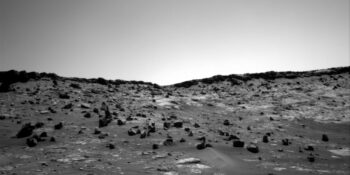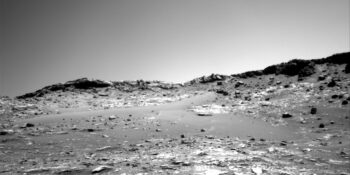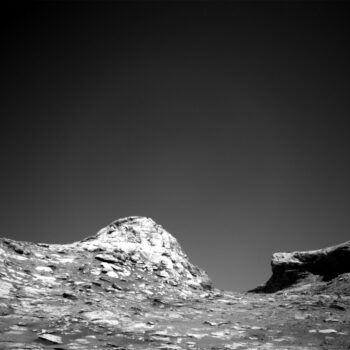
Curiosity Front Hazard Avoidance Camera Right B image acquired on Sol 3306, November 24, 2021.
Credit: NASA/JPL-Caltech
NASA’s Curiosity Mars rover at Gale Crater is now performing Sol 3307 duties.
“As we head into a long weekend for the Thanksgiving holiday in the U.S., Curiosity will take advantage of some extra time at the Zechstein drill location to conduct even more science,” reports Lauren Edgar, a planetary geologist at the USGS Astrogeology Science Center in Flagstaff, Arizona.

Curiosity Chemistry & Camera Remote Micro-Imager (RMI) photo taken on Sol 3306, November 23, 2021.
Credit: NASA/JPL-Caltech/LANL
The rover team has been busy the past two days planning 6 sols (plus a soliday) on Mars, which will give the robot plenty of work to do while the team takes a break from planning later this week.

Curiosity Right B Navigation Camera image taken on Sol 3306, November 23, 2021.
Credit: NASA/JPL-Caltech
Edgar adds that, while most of the research team would shy away from leftovers from three years ago, Curiosity is diving into a sample from the “Rock Hall” drill target which the Mars machinery been carrying since its time on Vera Rubin ridge (Sol 2261).
Power hungry
It turns out that the multisol plans this week are a great opportunity to do some power hungry Sample Analysis at Mars (SAM) Instrument Suite and Chemistry & Mineralogy X-Ray Diffraction/X-Ray Fluorescence Instrument (CheMin) analyses.

Curiosity Right B Navigation Camera image taken on Sol 3306, November 23, 2021.
Credit: NASA/JPL-Caltech

Curiosity Right B Navigation Camera image taken on Sol 3306, November 23, 2021.
Credit: NASA/JPL-Caltech
“SAM will conduct an experiment with the “Rock Hall” sample to test how organics are preserved in the presence of mixed iron oxides and clays on Mars,” Edgar notes.
Speaking of leftovers, CheMin will take advantage of the “Zechstein” sample (only from three weeks ago…) which hasn’t been dumped yet.

Curiosity Right B Navigation Camera image taken on Sol 3306, November 23, 2021.
Credit: NASA/JPL-Caltech
“We will analyze it again to measure if it changed while it sat in the warmer temperatures within CheMin,” Edgar says.
Generous helpings
The rest of the plan includes generous helpings of Mastcam and Chemistry and Camera (ChemCam) to document the nearby stratigraphy and analyze the composition of bedrock, diagenetic features, and float blocks that have tumbled down from higher up on these slopes.
“In addition to all of the geology observations, Curiosity will also be busy with a lot of environmental monitoring to assess the dust content in the atmosphere and search for dust devils and clouds,” Edgar points out.

Curiosity Right B Navigation Camera image taken on Sol 3306, November 23, 2021.
Credit: NASA/JPL-Caltech
Bonus science
In an earlier report, Kristen Bennett, a planetary geologist also at the USGS Astrogeology Science Center, notes that a recent plan did not fully execute over last weekend, so Curiosity remains at the Zechstein drill location.
“There are always more observations to take, so this extra time at Zechstein means bonus science. Our current location has great views of the pediment and several rocks that look like they tumbled down from either the pediment capping unit (known as the Stimson formation) or the layer that is directly beneath the Stimson,” Bennett says.

Curiosity Right B Navigation Camera image taken on Sol 3306, November 23, 2021.
Credit: NASA/JPL-Caltech
Rock targets
“We already obtained observations of a few of these rocks, but with the extra time the team decided to target more of these blocks to see if they are similar or different than the previous targets,” Bennett adds.
“Cairngorm Stone” is a dark rock thought to be from the Stimson formation that was documented with a ChemCam Laser Induced Breakdown Spectroscopy (LIBS) observation and a Mastcam stereo mosaic in a recent plan.
The “Carmyllie” target is a block that may be from the base of the pediment and it was documented with a Mastcam mosaic, Bennett reports. Other observations include ChemCam LIBS targets at “Hessilhead” on bedrock that appears to have been diagenetically altered, and at “Cullaloe” on more standard bedrock. Diagenesis is the process that describes physical and chemical changes in sediments.

Curiosity Right B Navigation Camera image taken on Sol 3306, November 23, 2021.
Credit: NASA/JPL-Caltech
The primary activity in a Sols 3306-3308 plan was the first part of the SAM derivatization experiment of the Rock Hall sample.
“This sample has been in a doggy bag for 3 years, so it will be exciting to learn what it can tell us about the Vera Rubin ridge where it was taken,” Bennett explains. “Data from this experiment will be used to better understand organic preservation in the presence of mixed iron oxides and clays.”

